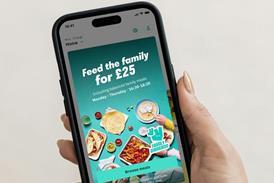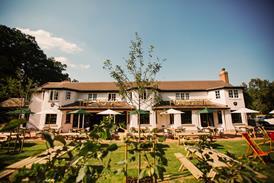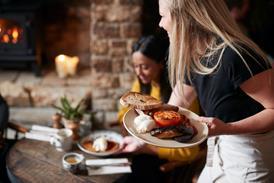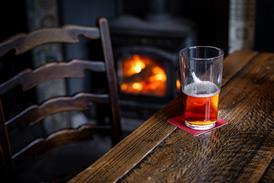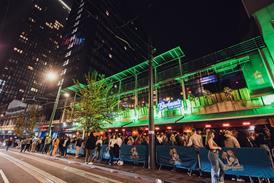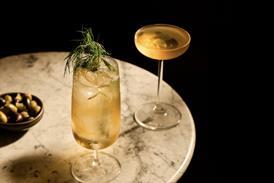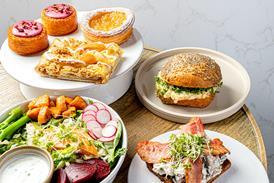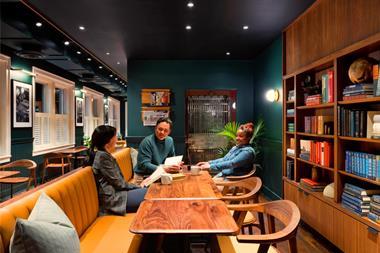Late last month, M&C Allegra Foodservice and Restaurant magazine took 30 leading operators to New York as part of their 72 Hours in… series. Their time was divided between exploring the independent and edgy concept melting pot that is Brooklyn and the more brand-conscious Manhattan. Below are some of the highlights from the trip:
“My guarantee is that when it comes to food, I will never steer you wrong,” was the claim of our host and guide Lawrence Weibman, or the ‘Food Guy’ as he is known in the US and one that, in 72 hours in
New York, he managed to live up to, whether that be premium fried chicken, southern pies & sides, brisket bagels, dry rub barbecue, meatballs, gluten-free fare or Venezuelan sandwiches.
But first, as seems obligatory, a strong coffee and pastry to start. Blue Bottle Coffee, started in California 10 years ago, the artisan coffee shop concept has grown to a small network of cafés, wholesale partners, an espresso cart, and some vintage German coffee roasters. The company’s site in Brooklyn highlighted the best a coffee shop should offer, a unique communal space, stripped-back surroundings and, of course, good coffee. The Brooklyn coffee shop ethos is based around the “story” and that the consumer should be able to see the coffee-making process, storage space et al. You can see where Starbucks has taken some of its inspiration from as it looks to debrand some of its neighbourhood sites.
While Brooklyn is known for its independent operator feel, a number of branded operators or those with pretentions to be a chain have started to take a punt of the increasing regeneration of the area (and lower property prices compared to Manhattan) to grow this offer (Shake Shack being a case in point). Hill Country Chicken, which is based in a former library/local council building, currently operates two sites but is eyeing further expansion. A reoccurring theme during the trip was that the US has taken the fast-casual model and looked to put a premium slant on old favourites.
Hill Country Chicken is a premium/next generation take on KFC offering “crave-able, comfort food”, but matched with a stripped back, 1950s diner-influenced fit out. Customisation was again at the forefront of many of the concepts we encountered on the trip and the site’s soda machine was a draw in itself, prompting many operators on the trip to note how inexpensive soda offers will be the next point of difference explored in the UK. Again, the story behind the concept, in this case “grandmother’s recipe” was front and centre. Next door sat sister concept, Hill Country Barbecue Market, a 300-cover 12,000sq ft site, which can get through more than 900 covers during an evening. The site honours the barbecue and live music capital of Texas and takes its “cue” from the meat-markets-turned-barbecue-joints of central Texas with their distinctive, dry-rub style.
The next two businesses were perfect examples of the Brooklyn ideal of more is less when it comes to site design (DIY) and use of space. Both Mile End Delicatessen and Pies N Thighs wore the stripped-back nature of their offers, in order to let the food do the talking, proudly on their sleeves. Both provided examples of taking traditional, inexpensive food and making it premium. Mile End Delicatessen offered an interpretation of a Montreal-style Jewish deli and gave a great example of delivering one product extremely well.
Fried chicken is having an extended moment in the US at present, and Pies N Thighs has been at the forefront for developing a modern twist on an old favourite. The place popularised brining – immersing chicken in an osmotic solution that adds salt to the flesh and renders it softer. The unit is small, rustic and slightly disorganised (the signage in the front window looks like the work of a nine-year-old), but crucially packed with a young demographic from early morning until late into the evening. The concept’s signature dish: buttermilk-fried chicken sandwiched in a fluffy biscuit spread with home-made honey butter may have had something to do with the queues we encountered.
From the global appeal of fried chicken to the untapped potential of Venezuelan food and drink. Caracas Arepa Bar currently operates four sites across New York and is, and many on our trip would argue, redefining sandwiches or in this case arepa in a restaurant or bar environment. In Venezuela, they are at the centre of every meal; from breakfast to lunch, dinner, and the occasional after-party treat, which has allowed Caracas to build an all-day dining format. Made from scratch daily, they have been described as “dense yet spongy corn-flour rounds, pita-like pockets, corn muffins, cake-swaddled mélange, white corn cakes” among other things, complete with a number of fillings such as shredded beef. That’s if you get past the bar and its 50-plus varieties of rum. The business expertly combines nostalgia, entrepreneurship and authenticity. Fette Sau (German for fat pig) blends most of the above key points, in terms of designs points and doing one product extremely well then takes it a stage further. From the TV fireplace, to the food drawings and explanations on a feature wall and the threatening collection of knives used as beer pump designs, everything is set at a juxtaposition to the offer itself, dry-rub barbecue and craft beers, which have become famous across the US. If you thought Drake & Morgan had taken unique design pointers to a new level then Fette Sau is working in a different universe with the communal seating adding to the chaotic nature of the place.
Dos Toros Taqueria was the second concept visited in Brooklyn that could be clearly positioned under the “all set to be a chain” banner. The company, which was started by Leo and Oliver Kremer, two brothers from San Francisco, has taken the Chipotle model and applied “San Fran-style mission burritos” to it. The business has grown quickly to seven sites. The menu is short and sweet, so as they say “you can spend more time eating and less time trying to figure out what to order”. Polished design and tight menu backs up the group’s target to one day have a national presence.
The first day in New York was ended (in terms of eating-out) by a trip to Roberta’s, which has grown from an artisan pizza restaurant into its own lifestyle concept, food and drink commune and international brand. The site comes complete with a takeout section, radio station, tiki bar disco and Michelin-starred restaurant Blanca all among the compound’s graffiti-covered corrugated metal surrounds. Among the continual ruckus can be found some of the best pizzas in Brooklyn, but also great pork chops. Roberta’s can rightly claim to be the current epicentre for the whole hipster movement transcending on Brooklyn.
New York, new thinking
Operating for 120 years through five generations of the same family, the world-famous Katz’s Deli in Manhattan can still throw up a few surprises. The site gets through 7,000 kilos of pastrami per week and has 20,000 kilos of beef in stock.
Operating for 24 hours a day at weekends, the site, which accommodates between 400 and 4,000 people a day, sees its biggest rush at between 2am and 4am as consumers see its offer as the perfect hangover cure. From one location, it ships its produce across the whole of the US and is currently looking to ship items across to the UK. It also continues to operate a ticket system at the front door, allowing people to pay when they want, encouraging them to take their time and order more.
The Meatball Shop concept, seven sites and growing, works under the ethos “eat simple, eat sustainable, eat good food with no strings attached”. Again the focus is on delivering produce well, initially starting out as a counter-service concept before becoming a full-service dining experience with 85 meatball varieties in its repertoire. Having expanded to six sites in a short time, the group is now looking at “iconic growth” across the US and also internationally, with London on the wish-list. Katz’s has been spending the past year putting in processes and systems aimed at expanding a business, which is currently turning over $3.9m a year but has been valued at close to $50m.
With Leon having a renaissance in the UK, it is interesting to note the new generation of health-conscious concepts currently launching in the US, especially in the fast-casual market. Last year, we explored Lyfe Kitchen in Chicago, while in Manhattan
that baton is picked up by Little Beet
and Sweetgreen.
The USP of Little Beet is that its menu items are 100% gluten-free or “100% guiltin’ free” as it marketing message declares. Developed by chef Franklin Becker, Little Beet offers gluten-free items and fresh-pressed juices, the menu includes chai-spiced quinoa breakfast oatmeal, sandwiches and kale salad with pumpkin seeds, currants and pecorino in a take-out and eat-in environment. The site we visited had an average weekly turnover of $90,000 and about $18,000 a day. The company hopes to grow from two sites to seven by the end of this year. In a nice twist on US eating habits, it is positioned next door to sister concept, the Melt Shop, Becker’s third outpost of his grilled cheese mini-chain, which features a menu of sandwiches (including the burger melt), soups, salads and shakes, plus a beer and wine menu. Both places are highly branded and set up to be expanded.
If there was one concept visited on the trip, which was set up to be both a national and international brand, it was Sweetgreen, which ticked a number of key modern consumer boxes – healthy, sustainable, fast-casual, community-focused and story-driven. Focused on “fast and delicious food that’s healthy for you”, it secured $18.5m of new investment late last year from restaurateurs such as Danny Meyer (Union Square Hospitality) and Daniel Boulud (Daniel, Café Boulud), as it looks to significantly grow its c30-strong estate. It gets its healthy/sustainable stance across through key messaging in-store, whether that is through its manifesto board, in-store newspaper or packaging. This is a mighty brand in waiting.
Brooklyn and Manhattan are two sides of the same coin, one likes to play up to its hipster image, while the other likes its brands to have a story and individuality. Both places offer great examples of how the fast-casual market has come to dominate the eating-out scene in the US, which is being transferred around the world. It is all about the story and concepts in New York are continuing to write new chapters around old and well-loved themes.









